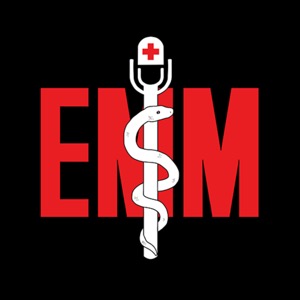Episode 929: Traumatic Aortic Injury
Emergency Medical Minute - Un pódcast de Emergency Medical Minute - Lunes

Contributor: Aaron Lessen MD Educational Pearls: Aortic injury occurs in 1.5-2% of patients who sustain blunt thoracic trauma Majority are caused by automobile collisions or motorcycle accidents Due to sudden deceleration mechanism accidents Clinical manifestations Signs of hypovolemic shock including tachycardia and hypotension, though not always present Patients may have altered mental status Imaging Widened mediastinum on chest x-ray, though not highly sensitive CT is more sensitive and specific, and signs of thoracic injury include an intimal flap, aortic wall outpouching, and aortic contour abnormalities In hemodynamically unstable or otherwise unfit for CT patients, transesophageal echocardiogram may be used Four types of aortic injury (in order of ascending severity) I: Intimal tear or flap II: Intramural hematoma III: Pseudoaneurysm IV: Rupture Management Hemodynamically unstable: immediate OR for exploratory laparotomy and repair Hemodynamically stable: heart rate and blood pressure control with beta-blockers Minor injuries are treated with observation and hemodynamic control Severe injuries may receive surgical management Some patients benefit from delayed repair An endovascular aortic graft is a surgical option Mortality 80-85% of patients die before hospital arrival 50% of patients that make it to the hospital do not survive References Fox N, Schwartz D, Salazar JH, et al. Evaluation and management of blunt traumatic aortic injury: a practice management guideline from the Eastern Association for the Surgery of Trauma [published correction appears in J Trauma Acute Care Surg. 2015 Feb;78(2):447]. J Trauma Acute Care Surg. 2015;78(1):136-146. doi:10.1097/TA.0000000000000470 Lee WA, Matsumura JS, Mitchell RS, et al. Endovascular repair of traumatic thoracic aortic injury: clinical practice guidelines of the Society for Vascular Surgery. J Vasc Surg. 2011;53(1):187-192. doi:10.1016/j.jvs.2010.08.027 Osgood MJ, Heck JM, Rellinger EJ, et al. Natural history of grade I-II blunt traumatic aortic injury. J Vasc Surg. 2014;59(2):334-341. doi:10.1016/j.jvs.2013.09.007 Osman A, Fong CP, Wahab SFA, Panebianco N, Teran F. Transesophageal Echocardiography at the Golden Hour: Identification of Blunt Traumatic Aortic Injuries in the Emergency Department. J Emerg Med. 2020;59(3):418-423. doi:10.1016/j.jemermed.2020.05.003 Steenburg SD, Ravenel JG, Ikonomidis JS, Schönholz C, Reeves S. Acute traumatic aortic injury: imaging evaluation and management. Radiology. 2008;248(3):748-762. doi:10.1148/radiol.2483071416 Summarized by Jorge Chalit, OMS3 | Edited by Meg Joyce & Jorge Chalit Donate: https://emergencymedicalminute.org/donate/
